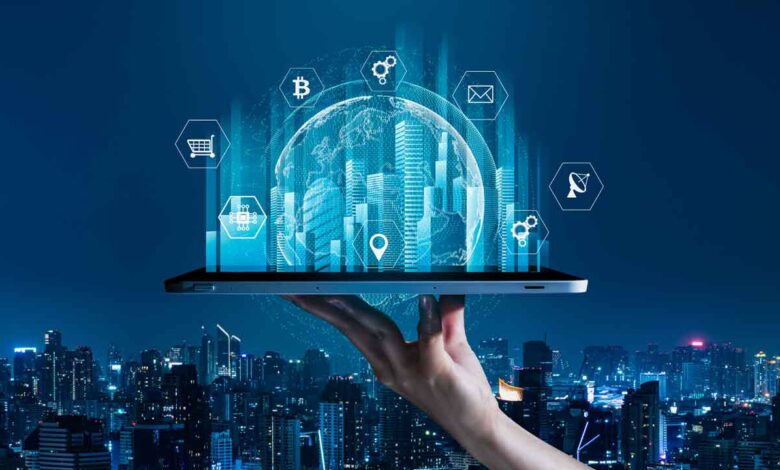Edge Computing vs. Cloud Computing: Key Difference

In recent years, the importance of data processing and storage has increased. Two well-known technologies that have had a significant impact on how we manage information are edge computing and the cloud. Both provide strong answers, yet they serve different purposes and have unique qualities.
Edge computing brings computers closer to the data source to speed up response times. On the other hand, cloud computing charges a set monthly price in exchange for providing computing technologies via the Internet.
In this article, we highlight the primary differences between these two computing systems.
What Does Cloud Computing Mean?
Cloud computing is a concept that allows users and organizations to access computer resources like servers, storage, databases, networking, software, and analytics through the internet.
Companies can rent these resources from cloud service providers like Amazon Web Services (AWS), Microsoft Azure, or Google Cloud Platform in place of maintaining them on-premise.
The essential features of cloud computing are:
- Centralized data processing: A sizable number of data centers handle and store the majority of the world’s data.
- Scalability: Companies can easily scale up or down resources in response to demand without having to invest money in physical infrastructure.
- Accessibility: As long as there is an internet connection, cloud services are essentially accessible from anywhere.
Use cases of cloud computing
- Data backup and disaster recovery
- Machine learning and big data analysis
- Storing lage dataset
- Hosting websites and applications
What Do You Mean by Edge Computing?
Edge computing is a distributed computing paradigm that aims to move data processing closer to the point of demand, which is typically close to the data sources.
They allow data to be processed locally on edge devices or edge servers instead of being sent all the way to a centralized cloud server, enabling real-time analysis and decision-making.
Edge computing’s salient features are:
- Reduced need to transfer massive volumes of data to distant data centers: Localized data processing processes data closer to the source.
- Minimal latency: Edge computing enables faster response times and data processing by removing the need for data to travel to a centralized cloud.
- Bandwidth optimization: They contribute to bandwidth optimization by lowering the volume of data transferred to the cloud. This can save expenses and enhance performance in areas with limited bandwidth.
Use cases of edge computing
- Smart Cities and Io
- Autonomous vehicles
- Virtual and augmented reality
- Industrial automation and robotics
Edge Computing vs. Cloud Computing: Key Differences
| Cloud Computing | Edge Computing |
| Cloud computing uses centralised servers located in large, remote data centres. | However, it is a globally dispersed and highly distributed computer infrastructure that is situated closer to the devices and consumers. |
| It is suited for applications that are not time-sensitive. | It is ideal for low latency, where every millisecond counts |
| It needs internet connectivity. | It can work without internet connectivity. |
| An expensive and intensive operational activity for the company. | Automated scalability with zero-touch provisioning |
| It is suitable for in-depth and long-term analysis. | It is better for fast and real-time analysis |
1. Security and privacy considerations
Security is a key component of cloud and edge computing. Edge computing improves data privacy by handling sensitive data locally and minimizing exposure to possible security issues while in transit.
However, maintaining edge security necessitates robust access control, encryption, and authentication systems to prevent vulnerabilities.
Cloud computing businesses invest a lot of money in security measures to protect data stored in centralized data centers. They provide multi-factor authentication, advanced encryption, and compliance certifications to guarantee data integrity and confidentiality.
Even with cloud services’ centralized security management, businesses still need to follow best practices to safeguard information viewed and transferred online.
2. Location of data processing
The location of data processing is one of the main distinctions between edge and cloud computing.
- Cloud computing
This method involves processing data on centralized computers housed in sizable data centers, frequently far from the source of the data. Applications like data backup or large-scale data analytics that can tolerate some latency and don’t require instantaneous data processing are a good fit for this approach.
- Edge computing
On the other hand, edge computing moves data processing closer to the site of data generation, which may be anywhere from a factory floor to a car or a mobile device. As a result, data travels less distance and responds more quickly and with less delay.
3. Bandwidth and data transport
Another significant difference between cloud and edge computing is how they manage bandwidth and data transport.
- Cloud Computing
In cloud computing, massive volumes of data are sent to centralized data centers for processing via the internet. This might result in a large quantity of bandwidth being used, which can be costly and ineffective, particularly for applications like video surveillance or Internet of Things sensors that generate large amounts of data.
- Edge Computing
Edge computing reduces the amount of data that needs to be moved to the cloud by processing data closer to the source. This can result in cost savings and lower bandwidth utilization, particularly in situations where transferring all data to the cloud would not be feasible.
For example, a smart camera can stream video continuously but only send relevant data to the cloud once it has done local content analysis.
4. Scalability as a big difference
Scalability is a feature of both edge and cloud computing, but they handle it in different ways.
- Cloud Computing
The scalability of cloud computing is practically infinite. Without having to handle real infrastructure, businesses may easily raise or decrease their cloud resources based on demand.
Cloud service providers, such as AWS or Azure, are a great option for companies with variable workloads because they can dynamically allocate resources to address surges in traffic or data processing needs.
- Edge Computing
While edge computing lacks scalability, cloud computing provides scalability. Edge computing can scale by adding more edge devices or nodes.
It can be more difficult to expand an edge computing network than to simply scale cloud services since more edge infrastructure must be deployed and maintained.
Wrapping Up
Both cloud computing and edge computing are strong technologies with clear benefits. Making an informed choice will be supported by your comprehension of their main distinctions and your consideration of the particular requirements of your application.
By selecting the right approach, you can maximize your data processing infrastructure for improved performance, security, and efficiency.





